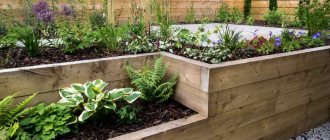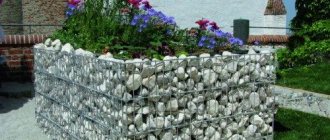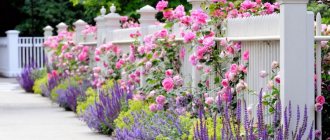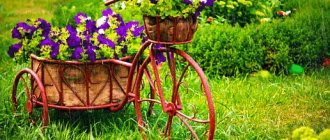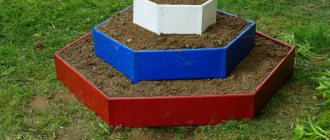Petunia is an incredible flower that is popular in garden design, valued for its beauty and vibrancy. The variety of shades of plants allows you to choose the appropriate crop option for different styles of landscape art. Plants can be planted both in pots and in flower beds, mixing original flower arrangements. To get a beautiful decoration for your garden, you can make your own petunia beds . We propose to consider several ideas for creating such structures.
Features of using petunia in landscape art
There are different varieties of petunias for flower beds; they differ not only in the color shades of the petals, but also in the shape of the roots. Plants look great in the design of mixborders, rockeries, and are used in vertical gardening, in decorating pergolas, balconies or terraces.
You can use rectangular flower beds, planting crops in them in even rows. If the design is curved, flowers can be used to outline the borders. Ampelous plant species are relevant for decorating large boulders.
The combination of petunia flowers in the flowerbed with other plants - left-flowered (matthiola), marigolds, pansies, tulips - is actively used. You can combine bright flowers with hostas, cereals, fuchsia or pelargonium.
Video tips: review of petunia varieties and care for them
It’s not for nothing that summer residents fell in love with petunia - for all its unpretentiousness, it has decorative properties that few garden flowers can compare with.
Petunia belongs to the nightshade family, like potatoes. Until the 19th century, she lived a quiet and inconspicuous life, until the delicate pretty flowers were examined by breeders. They grew hybrid varieties based on it, which gave rise to decorative species. Today, every self-respecting owner of a summer house, country plot or balcony tries to plant this amazing plant.
Do-it-yourself vertical flowerbed made of chain-link for petunia
You can make a beautiful vertical flowerbed from a mesh. In addition to the chain-link mesh, prepare:
- flower container;
- flower seedlings;
- textile.
You can learn more about the process of creating such a flower bed from our article “Do-it-yourself vertical flower beds: popular ideas for creating garden decor.”
You need to make a cylindrical frame from the mesh, place fabric material inside it, place the selected pot down, and fill the structure with soil. Then the soil should be watered so that it settles a little and compact it around the perimeter of the pot. Next, the fabric is cut in different places, and seedlings are planted in the resulting “holes.” Now you just need to water the structure and watch the transformation of the flower garden.
You can see the process of creating such a flower garden in this video.
Step-by-step instructions: description and photo
How to make it yourself from mesh?
An excellent solution for landscaping a local area or garden would be a vertical flower bed with blooming petunia. You can entrust the construction of such a composition not only to a landscape designer, but also to create it yourself from scrap materials. To achieve this goal, there are many ways, one of which will definitely be to your liking, and everyone will be able to choose something special for themselves, suitable only for them.
This creative activity will not require much time and effort , you will only need a little imagination and imagination. In addition, you can create such a composition from scrap materials without investing money.
Metal mesh is quite often used to create vertical compositions.
We offer a visual video about making a vertical flower bed from a mesh with your own hands:
With rocks
A vertical flowerbed will look much more interesting if you complement it with an alpine slide or build parapets, create the illusion of mountain peaks using natural stones, or dig out various reservoirs, which are then decorated with cobblestones.
A vertical flowerbed made of mesh and stones is constructed like this::
- Bend the mesh in the shape of a snail.
Important! The snail should be assembled from two layers. They should consist of galvanized mesh and be located parallel to each other at a small distance. - Place decorative stones between the layers of the snail. Both pebbles and larger stones are suitable, the most important thing is that they do not fall out of the mesh cells.
- A free space is formed between the meshes; it should be filled with soil, in which seeds or petunia seedlings should be planted.
Mesh, flowerpot, geotextile
For this version of a vertical flower bed, you need to choose a grid with small cells. A vertical flowerbed made of mesh and stones is constructed as follows :
- Roll the mesh into a cylinder shape. To prevent the mold from falling apart, you must use plastic clamps or wire.
- Place the mold in a pot of larger diameter; you can use a flowerpot.
- Take a piece of geotextile or similar black material and line the inside of the cylinder with it.
- Pour soil into the resulting structure, and fill the remaining unfilled space with substrate.
- Cut holes in the textile through the mesh. The holes made in a checkerboard pattern look original.
- Plant the seedlings in the soil, previously deepened with a finger through the holes.
- Over time, the plant will fill all the free space, and the cylinder will look like a flowering pillar.
If petunia is planted by seeds, then the seeds must be mixed with soil before planting.
From a plastic pipe
A vertical flower bed made of plastic pipe can look different, either hanging on a wall or fence, or standing on some surface. The place that needs to be improved will help you make your choice .
First way
You can decorate an unsightly wall of an outbuilding or a fence. A pipe cut lengthwise is suitable for this. You can use water or sewer pipes made of plastic.
To implement this method you need:
- Cut the pipe into the required number of parts of different lengths, cut each part lengthwise into two halves.
- Make plugs on the sides of the pipes.
- Place the pipes on a vertical surface according to the composition. They can be hung on hooks or secured with self-tapping screws.
- Pour soil into the pipe and sow petunia.
Second way
To implement this option, you will need two pipes of different diameters. To implement this method you need :
- Drill several holes in the pipes. In a pipe with a smaller diameter, holes are needed for water, in a pipe with a larger diameter - for petunias.
- Bury a large pipe into the soil, or fix it in any other way so that it stands vertically.
- Wrap the smaller pipe with burlap or other cloth, this is necessary so that when watering the water does not erode the soil around the roots of the plants.
- A second pipe of smaller diameter is inserted into the large pipe, and a substrate mixed with petunia seeds is poured.
From flower pots
It often happens that a large number of different containers accumulate in the garden, which have not been used for a long time, but it is a pity to throw them away. This could be old dishes, pots or buckets. They can be used to create a petunia bed. And of course, you can use new flower pots to implement this option. The most important thing is to think about creating a unified landscape style.
To create this vertical composition, you need to purchase a metal or wooden rod. The length of the rod should be several centimeters greater than the calculated height of the future composition.
To implement this method you need:
- Choose a place for a flower bed and place the largest pot there.
- Make a hole in the bottom of the pot and place the rod there. The rod must go as deep into the ground as possible so that the structure stands firmly on the ground.
- In the remaining pots, make holes at the bottom and string them onto the rod, one after the other, from larger to smaller.
- Fill all the pots with soil and plant the petunia.
From improvised means
In addition to all these methods, there are many other options for creating flower beds for petunias. You can use any materials that are lying around in the garden and are not being used. It can be:
- car tires;
- old furniture;
- cloth;
- shoes;
- plastic and glass bottles;
- hats;
- bags or sacks.
You can experiment with everything you have enough imagination for.
Quite often you can see flower beds made from car tires. To create a composition from them, the tires must be cleaned and painted in bright harmonious colors. From multi-colored wheels you can build a tower, a pyramid, any animal, a fountain and much more. Petunias are planted in tires.
You can use plastic bottles to create a flower arrangement . To do this you need:
- Cut all the bottles lengthwise and attach them to the wall or fence.
- Fill them with soil and plant petunia seedlings.
How to make a beautiful petunia flower bed using boxes
You can create a beautiful version of a flower garden using window boxes. They will look great placed on the wall of the barn in a chaotic manner; a hanging plant pot would also be perfect. In such designs, both regular and ampelous petunia look great.
Petunias and lobelias in a hanging pot
This arrangement option allows you to correctly plant a flower bed of petunias and lobelia; you can add pelargonium, verbena or ivy there.
Option number 3: “Blooming cart”
If you have an old cart or cart in your household that you were going to send to the trash, but everyone regretted it - this option is exactly yours!
You will need a lot of space for such a flower bed, so this option is good for large yards. So let's get started:
- In the place of the flowerbed we pour a mound of earth with a height that corresponds to the height of the open edge of the cart.
- We pour earth into the cart and tilt it towards the hill so that it seems as if the earth was pouring out of the cart.
- Now we sow or plant a cart with a hill with different flowers of petunias, so that the impression of scattered flowers is created.
The “blooming cart” looks very impressive and adds a rustic touch to the yard design. An excellent option for a country estate.
How do you like this option? An old stump and some stones, we think it’s not difficult to find
Creating a flower garden from tires
Flowerbeds with petunias at the dacha made from tires look very nice. This design is very simple to create. It is enough to take old unnecessary tires and put them one on top of the other. Soil is filled inside the formed space and flower seedlings are planted.
To prevent the black color of the tires from bothering your eyes, paint them with any acrylic paint, this will add originality to the design. Green shades look very beautiful, which will allow flower beds to merge with the vegetation.
What plants can be combined with?
Bush petunia is a fairly friendly plant that gets along well with other flowers. The selection of companions should be made based on the following criteria:
- color spectrum;
- harmony of forms;
- dimensions;
- method of growth and cultivation;
- seasonal similarities and differences.
Petunia goes well with spring flowers, but you need to remember that petunia blooms for a long period of time, so at the beginning of summer you will have to carefully clear the flowerbed of already dried spring neighbors. After these steps, the flower garden should not look like a bed with bald spots.
Therefore, daffodils, hyacinths, crocuses and tulips should be planted next to petunias along clearly thought-out geometric lines, which will be effective even after removing dead vegetation.
To make it easier to choose flowers for landscape design, we suggest looking at photographs of harmonious combinations of petunias with specific plants.
- You can emphasize the riot of colors of petunia with the outline of an openwork silver cineraria.
- Lobelia is a huge ball of small flowers that competes with petunia in its brightness and splendor, but at the same time they get along well with each other. Even ampelous varieties do not shade the lobelia if it is placed in the center, and the shoots of the petunia hanging from the flowerpot are directed downwards.
- The photo shows an example of the unity of marigolds, cineraria and petunia. They contrast with the stone design of the flower bed. Such a bright oasis among the monotonous greenery of the surrounding landscape combines the energy of life and the philosophical peace of stone.
- Ampelous mixtures of verbena and petunia are fascinating. Shape, color, size - everything is different, but the flowerbed looks harmonious.
- fern leaves go well with cascading petunia . The fern heads the flowerbed, sitting in the center of the exhibition, and bright flowers flow down like a waterfall.
DIY petunia flower beds made from PVC pipes
An original high flowerbed for petunia is made from PVC pipes of a suitable size. To create such a structure, holes are drilled in the pipes with parameters of 2-3 cm. Then the pipe is buried 1/3 of the height into the ground, and the substrate is placed inside.
Prepared seedlings are planted in the holes made or seeds are sown (depending on the time of year when the procedure is carried out). In the second case, the seed material is mixed with soil, which is then poured into the formed pipe. When the sprouts hatch, they will fill the nearby holes, growing into them. Using several of these pipes, you can form an unusual hedge or fence.
Growing seedlings
The secret of success is proper planting and rational care. Petunias grow quickly, spreading to the sides, eventually hanging down to a length of 40-100 centimeters. Cultivation begins with planting or purchasing seedlings. Seedlings are planted in mid-May (less risk of frost) in fertile soil in a sunny place.
Important! Petunias are very sensitive to weather conditions!
Growing the plant is not suitable for beginners, but the efforts will certainly pay off with beautiful flowering that lasts throughout the season until the first frost.
When to plant seedlings?
To create flower beds, annual plants are often used (with the exception of planting trees and shrubs in large pots), characterized by a long germination period and low resistance to temperature fluctuations. The first planting of plants on seedlings, taking into account the “summer” flowering, begins in February!
Petunia is a rather sensitive plant. It is better to ensure “wintering” in greenhouse conditions; by May the plant will become much more developed than its counterparts located outside the greenhouse.
Transplanting seedlings
The secret to exceptionally lush plants is replanting in late May or early June. Planting takes place in small plastic pots, where the flowers can grow freely and the root system is effectively protected from the cold. In order for the effect to persist after transplanting into the final pot, you first need to slightly moisten the flower, and then place it exactly at the same depth as the seed pot - then the plant will not be “shocked”. Frequent watering twice a day will ensure consistent conditions over the following weeks.
For convenience, before boarding, you should choose one of the options:
- combine soil with a hydrogel that absorbs and releases water without human supervision,
- or fill the container with a 2-3 cm layer of bark or peat to reduce water evaporation and weed development.
It is very important before planting any container: flower pot, flower towers or lawn, to always remove the “old” soil to reduce the risk of disease and parasite transmission. The old soil is replaced with peat.
Top dressing
Seasonal plants recommended for urban planting require intensive feeding. A special mixture of fertilizers will be required, constantly supplied to the roots. For petunia, synthetic fertilizers are applied in low concentrations (0.1%), applied maximum every 2 weeks directly to the substrate. For the best effect, apply multi-component fertilizer every 7-10 days (especially for blooming flowers, not nitrogen).
How to water?
Cascade petunias love water, and although excess water should be removed, the plant must be watered regularly (twice a day on hot days). Many varieties have their own water requirements.
Flowerbeds that do not require maintenance
For gardeners who don't have a lot of time and energy, lazy flower beds are the ideal solution. This option involves planting plants that require almost no care, fertilizing or other special conditions. They can delight with their flowering from the very beginning of spring until the end of autumn.
Peonies, sedum, geranium, astilbe, hosta and bergenia are perfect for a lazy flower bed. Adding aster and phlox will decorate the flower bed with bright flowers.
Stores often offer sprouts and a ready-made scheme for planting them. Such a flowerbed will delight its owners with flowering from early spring to late autumn.
In addition to the plants listed above, the following are ideal for organizing a lazy flower bed: clematis, daylily, cornflower, daffodils, lupine and irises.
Photos of flower beds of perennials amaze with their beauty and diversity. They must certainly be present on the plot.
Floribunda
This class can be called a successful combination of large and multi-flowered petunias. They have elegant, large flowers of a wide variety of colors that are resistant to cold weather and rain, so growing floribunda petunia does not cause much trouble. Such plants are ideal for decorating flower arrays and large flower beds.
Petunia floribunda amazes with its color diversity
Luxurious petunia floribunda deep dark red color
Soft pink petunia flowers with bright pink veins
Unusual petunia of white and yellow color
Ampelous
Phytodesigners love it for its long, flexible vine branches, which are completely covered with luxurious flowers. Plants easily tolerate outdoor life. In landscape design, ampelous petunia is used to decorate the banks of reservoirs, hills and create bright flower beds.
Thanks to its flexible branches strewn with flowers, ampelous petunia has become a favorite of phytodesigners
How to create an unpretentious flower paradise: expert advice
Receiving a guarantee of an unpretentious flower garden is not the guarantee of a beautiful garden.
An important point is the correct planting and design of flowering plants. 1. Blooming carpet
Lovers of bright lawns and lawns that do not require extensive care can be offered to create a lawn-type flower garden at their dacha. To do this, you just need to sow the designated area with wildflowers. The most successful flowers for such a lawn can be poppies, clovers, daisies, cornflowers and other similar varieties.
Make a Moorish lawn from poppy seeds - it will require minimal attention, but it will look very, very presentable
Such a “carpet” does not need constant watering or cutting. A picnic or meeting with friends in such a home meadow will give you a feeling of closeness to nature and real relaxation.
2. Colorful arches and gazebos
If you have or are planning a gazebo at your dacha, think in advance about how to make it bloom. To implement this idea, we advise you to grow flowering, unpretentious vines:
Unpretentious climbing plants will also fit perfectly into the overall landscape in your garden or cottage.
- Clematis.
You can call this vine the most unpretentious of all. That is why it has become the most grown plant near porches and gazebos. - Maiden's grapes.
Also very popular in our regions. The bright leaves and decorative fruits of this plant cannot but please the eye. - Campsis arborescens.
Will decorate arches, gazebos, fences and any canopies around the house. Its bright flowers give the garden an oriental mood. - Climbing roses.
This flower will definitely make your gazebo or arch truly royal. A cup of early morning tea in a rose scent is the best start to a new country day. - Climbing annuals.
A simpler option is decorative beans, peas or morning glory. Having planted them once, you will definitely want to see them in your garden next year.
3. Unpretentious flowerbed
Forget-me-nots and daisies - just looking at these beauties will instantly lift your spirits
To create a fresh and unusual flower bed, experts advise combining flowers of the same year with perennials. So, perennial flowers should be planted at the base of the flower bed, and annual flowers should be changed every year, refreshing the flowerbed.
Viola and Turkish carnation are a vivid example of the boundlessness of the imagination of our mother nature
To summarize, we note that for constant bright flowering of unpretentious flowers for the garden, you need to give them maximum attention right away, so that you can then relax and admire the result. It is advisable to fertilize the soil, fluff it up and prepare the flowers for planting, taking into account the characteristics of each variety
You won't have to wait long, and soon your hardy flowers will decorate your cottage or garden. We wish you real blooming masterpieces!
How to care for the composition?
You can’t make a flower garden and forget about it. Of course, a flower bed requires care, and the better it is, the more positive things you can get from the plants.
It is necessary to ensure that the soil in the flowerbed does not dry out or crack. Daily gentle watering in the morning or evening will keep the plants in a fresh, vital state. Periodically, you can organize watering and fertilizing - this will help the plant grow into a lush ball. Petunia can be fertilized with organic matter (ash, manure) or mineral phosphates.




